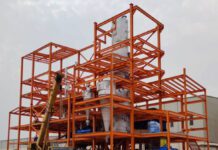Mitu Mathur, Director, GPM Architects & Planners
Mauritius is home to many flora and fauna and is widely known for its rich vegetation and wildlife; thus, nature is the driving force behind the building’s form. The building design is inspired by the concept of biomimicry, using leaves that showcase how the country is tied to its natural environment. The leaf motif inspires a dynamic and interesting roof design that has been emphasised by the louvres on all sides. Even the drop-off to the building is at the intersection of the leaf roof structure, which creates an interesting vantage point to view the whole building. All the major components of the complex have been placed in a way that they complement each other and at the same time are segregated to symbolise the different nature & typology of the spaces. Sustainable design practices form the backbone of the design. The building complex has been effectively oriented to allow optimum sunlight and ventilation. The use of sustainable building materials minimises heat gain and helps ensure the occupants’ thermal comfort. For greater thermal performance, the building also has green terraces. Inspired by a traditional jaali system, the facade of the building is planned with louvres to block the harsh sun and ensure ventilation, while also rendering an eye-catching form to the building.
Project Brief
To preserve and foster cultural values and strengthen Mauritius’ existing infrastructure, the Ministry of the Arts and Culture of the Republic initiated the development of two key institutions – The National Archives Department and the National Library. The objective of these institutions is to preserve the archival records of the nation, undertake research activities and produce resources for educational purposes for the public.
Spread over an area of 3.12 acres, the site planning of the complex judiciously responds to the climatic and contextual challenges of Mauritius. The site’s natural slope from northeast to southwest is maintained with a beautifully accentuated design. An integrated and seamless vehicular circulation plan has been proposed to provide barrier-free movement to its users, with segregated traffic plans for vehicles. The entrance to the complex is provided from the inner road to give ample space from the bustle of the outer highway. Shaded bicycle pathways and tracks along the site have also been designed specifically for pedestrians.
As one enters the building, they are greeted by a triple-height lobby area with a help desk. The building is planned to overlook the central courtyards that provide openness and help break the massive structure’s monotony. These courts also act as informal seating areas for the public, while ensuring ample light and ventilation within the building and providing a visual connection across all floors. The internal spatial planning of the building has been done symmetrically on either side of the common lobby to provide maximum traversal comfort to both the National Archives and the National Library Department. For ease of access for the general public, spaces such as the coffee shop, mess, multi-purpose hall, craft studio, and lecture/training room are planned on the ground floor. Orienting them towards the north gives them outdoor access while ensuring ample diffused sunlight during summer. On the other hand, the utility areas have been planned on the southern side to keep them away from the public zone and the main entry point.





